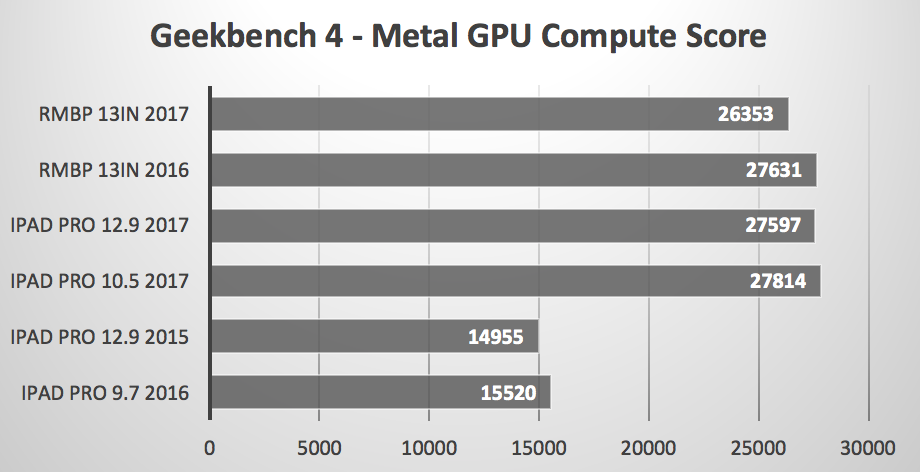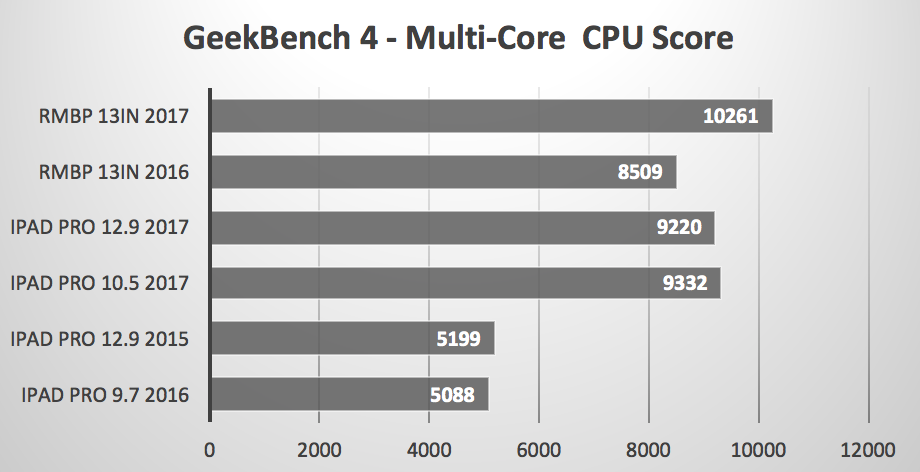Although Steve Jobs did not see the iPad as a laptop replacement, he probably did not anticipate the performance of the iPad Pro. You latest they show similar results in the Geekbench test as just now introduced 13-inch MacBook Pros.
Apple presents the iPad Pro not only as a functionally specific addition to the computer, but also as a possible replacement for it. That's why they have much higher performance compared to the standard iPad, larger and better quality displays and a better range of productive accessories.
At the same time, the increase in performance of the new iPad Pro is compared in the official presentations only with the previous generation, not with other devices. Website editors Bare Feats but they decided to look at this comparison as well and found that the hardware of Apple tablets and laptops is not only similar in design and physical parameters.
A total of six devices were compared:
- 13 2017-inch Macbook Pro (highest configuration) – 3,5 GHz dual-core Intel Core i7, Intel Iris Plus Graphics 650, 16 GB 2133 MHz LPDDR3 memory on board, 1 TB SSD storage on the PCIe bus
- 13 2016-inch Macbook Pro (highest configuration) – 3,1GHz dual-core Intel Core i7, Intel Iris Graphics 550, 16GB 2133MHz LPDDR3 memory on board, 1TB SSD storage on the PCIe bus
- 12,9 2017-inch iPad Pro – 2,39GHz A10x processor, 4GB memory, 512GB flash storage
- 10,5 2017-inch iPad Pro – 2,39GHz A10x processor, 4GB memory, 512GB flash storage
- 12,9 2015-inch iPad Pro – 2,26GHz A9x processor, 4GB memory, 128GB flash storage
- 9,7 2016-inch iPad Pro – 2,24GHz A9x processor, 2GB memory, 256GB flash storage
All devices were subjected to first the Geekbench 4 CPU test for single and multi-core performance, then the graphics performance test using Geekbench 4 Compute (using Metal) and finally the graphics performance when generating game content via GFXBench Metal Manhattan and T-Rex. The final test used 1080p off-screen rendering of content in all cases.

Measuring the performance of processors per core did not yield very surprising results. The devices are ranked from newest/most expensive to oldest/cheapest, although while the performance of individual processor cores didn't improve much between last year's MacBook Pro model and this year's, it did go up quite significantly for iPad Pros, by almost a quarter.
Comparing the performance of multi-core processors was already more interesting. This increased significantly between device generations for MacBooks and iPads, but the new tablets have improved so much that they exceeded the numbers measured for last year's MacBook Pro model by a significant amount.
The most interesting results came from the measurement of graphics performance. It has almost doubled year-on-year for iPad Pros and has completely caught up with MacBook Pros. When measuring performance during the rendering of graphic content, the iPad Pro even outperformed last year's and this year's MacBook Pro.

Of course, it should be emphasized that the benchmark results represent very specific conditions of hardware usage, and the performance manifests itself differently when operating systems and applications are used in real life. For example, it is typical for a desktop operating system that many processes run in the background – this also happens in iOS, but not nearly as much. Even the very functioning of the processors is therefore different, and it is therefore not entirely appropriate to suggest that Apple replace Intel hardware in MacBooks with its own from iPads.
However, the benchmarks are far from being completely unimportant and at least show that the potential of the new iPad Pro in particular is great. iOS 11 will finally bring it closer to the consequences for real practice, so we can only hope that software manufacturers (led by Apple) will take tablets more seriously and offer an experience comparable to desktop applications.



The hardware of the IpadPro will be able to replace even the MBP. I already wanted to buy it. BUT: The problem is in the functions of the application and the versions of the application for iOS are trimmed compared to the OSX versions. Even the little things bother me. For simple video animations, I use Keynote and export to Quicktime movie. Keynote can't do this on iOS. The iOS version of iMovie can't click on the green background either. Adobe also only has toy-like apps for iOS. She's just unlucky. It can only be good for out-of-the-box creatives, for photos, etc. Otherwise, in my opinion, it is impossible as a replacement for MBP.
An electronic watch will be added...
So mainly here we are comparing two different architectures, so the graphs from the benchmark are nice, but in practical use they are apples and pears.
It is true. On the other hand, the user is interested in the work done and its speed, and this can be compared. Even though there are differences here for the user, and again - for some it doesn't matter, for others it's incomparable.
And what is the work done anyway, when I have to work with 'semi-crippled' applications that have x thousands of limited functions equivalent on a PC/Mac?
Not at all, that's just your one sided view. You can also work with applications that are easier to control on the iPad or even do not have an equivalent on the Mac. You can't throw everything in one bag.
That's certainly true.
So show me an application that is easier and faster to use on the iPad than on the Mac... Ha, ha, ha, ...
What good would it do you if you don't have both? No use, don't say that. ;-)
Especially the divas fall for it. This does not speak about the performance of the iPad, but rather about the fact that they gutted the MBP and turned it into a poor, inefficient tablet. :-WITH
A demonstration of how a good PR department can turn the fact that the MacBook Pro is stagnant and worth shit into a success.
I was also thinking of trying to work on the iPad and was looking for the Pro version with the Apple keyboard, but I stumbled across it pretty quickly. For me, for example, a big problem is that I can't open 2 Word files next to each other and I can't work with two documents at the same time. From what I've searched on the net, this problem is generally blamed on Microsoft, but I rather see the problem in the fact that iOS was originally designed for a different type of use/use than OSX, so getting close to a desktop OS is only possible for iOS the cost of considerable development. Well, let's see where iOS 11 will go :-)